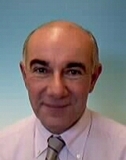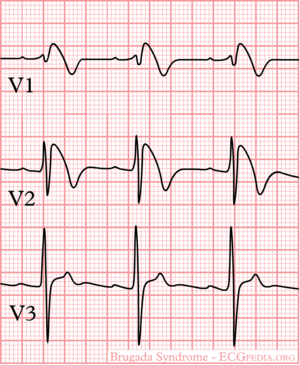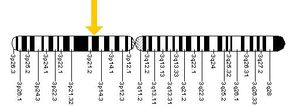Brugada Syndrome: Difference between revisions
Jump to navigation
Jump to search

m (Brugada syndrome moved to Brugada Syndrome) |
mNo edit summary |
||
| Line 1: | Line 1: | ||
{{authors| | {{authors| | ||
|mainauthor= [[user:Pgpostema|P.G. Postema, MD]] | |mainauthor= [[user:Pgpostema|P.G. Postema, MD]] | ||
| Line 7: | Line 6: | ||
|editor= [[user:Drj|J.S.S.G. de Jong, MD]] | |editor= [[user:Drj|J.S.S.G. de Jong, MD]] | ||
}} | }} | ||
[[Image:Brugada.png|thumb|Typical ECG abnormalities in Brugada syndrome: ST elevation in V1-V3, without ischemia.]] | |||
[[Image:scn5a.jpg|thumb| The SCN5a gen is located on the short arm (p) of chromosome 3]] | |||
[[Image:brugada.jpg|thumb| Dr. Pedro Brugada. Pedro and Josep Brugada described in 1992 a landmark publication with a case-series of 8 patients with sudden cardiac death. <cite>Brugada</cite> Currently four members of the Brugada family conduct research after the syndrome that has been named after them.]] | |||
The '''Brugada syndrome is an hereditary disease that is associated with higher risk of sudden cardiac death'''. It is characterized by typical ECG abnormalities: '''ST segment elevation in the precordial leads (V1 - V3)'''. | |||
''' | '''Characteristics of the Brugada syndrome:''' | ||
*[[w:Autosomal_dominant|autosomal dominant]] inheritance'''. If one of both parents are affected, their children have a 50% chance of inheriting the disease. | |||
*Man are more often symptomatic than women, probably by the influence of sex hormones on cardiac arrhythmias. | |||
*The arrhythmias usually occur between 30 and 40 years of age. (range 1-77 yrs) and often during rest or while sleeping. | |||
*Only in about 30% of patients, genetic defects can be detected in the ([http://ghr.nlm.nih.gov/gene=scn5a SCN5A]) gen. In the other patients the disease is probably multi-genetic or caused by yet unknown genetic defects. | |||
*The right ventricular outflow tract (right before the pulmonary valve) is most affected in the Brugada syndrome. | |||
*The prevalence varies between 5-50:10.000, largely depending on geographic location. In some south-east Asian countries the disease is endemic and sometimes considered the second cause of death amongst young men (after car accidents). There it is called 'Sudden Unexpected Death Syndrome' (SUDS). In different Asian countries, different names have been given to the syndrome: in the Phillipines it is called ''bangungut'' (to rise and moan in sleep) and in Thailand ''lai tai'' (death during sleep) | |||
The Brugada brothers were the first to describe the characteristic ECG findings and link them to sudden death. Before that, the characteristic ECG findings, were often mistaken for a [[Right ventricular MI|right ventricle myocardial infarction]] and already in 1953, a publication mentions that the ECG findings were not associated with ischemia as people often expected.<cite>osher</cite> | |||
'''Diagnosis and treatment''' | |||
*Patients who are symptomatic (syncope, ventricular tachycardias or survivors of sudden cardiac death) have a mortality risk of up to 10% per year. In these patients an [[:w:nl:Internal_Cardiac_Defibrillator|ICD]] should be implanted. | |||
*Some groups advice an electrofysiologic investigation for risk assessment in Brugada patients,<cite>brug2</cite><cite>brug3</cite> but others could not reproduce the predicive value of these tests,<cite>priori</cite><cite>eckhardt</cite> so this is still controversial. | |||
*In large studies familiar sudden death is not a risk factor for sudden death in siblings. | |||
*In asymptomatic patients in whom the Brugada ECG characteristics are present either spontaneously or provoked by fever or sodium channel blockers (ajmaline, flecainide) life style advices are given, which include: | |||
**A number of medications should not be taken (amongst others beta-blockers, and sodium channel blockers such as certain anti-depressants and anti-arrhythmics) | |||
**Rigorous treatment of fever with paracetamol / Tylenol | |||
For a full list of the diagnostic criteria, see <cite>Wilde</cite> | |||
==External links== | |||
*Cardiogenetics website of the AMC [http://www.cardiogenetica.nl cardiogentica.nl] | |||
== | |||
* | |||
*[http://www.brugada.org Brugada.org ] | *[http://www.brugada.org Brugada.org ] | ||
*[http://www.genereviews.org/servlet/access?id=8888891&key=ghdBRjkdNXE6y&gry=INSERTGRY&fcn=y&fw=E0gK&filename=/profiles/brugada/index.html Genereview Brugada] | *[http://www.genereviews.org/servlet/access?id=8888891&key=ghdBRjkdNXE6y&gry=INSERTGRY&fcn=y&fw=E0gK&filename=/profiles/brugada/index.html Genereview Brugada] | ||
| Line 48: | Line 42: | ||
#Brugada pmid=1309182 | #Brugada pmid=1309182 | ||
#osher pmid=13104407 | #osher pmid=13104407 | ||
#brug2 pmid=11772879 | |||
#brug3 pmid=12776858 | |||
#priori pmid=11901046 | |||
#eckhardt pmid=15642768 | |||
</biblio> | </biblio> | ||
<analytics uacct="UA-807577-6"></analytics> | <analytics uacct="UA-807577-6"></analytics> | ||
Revision as of 12:38, 26 July 2007
| Author(s) | P.G. Postema, MD | |
| Moderator | P.G. Postema, MD | |
| Supervisor | ||
| some notes about authorship | ||

Dr. Pedro Brugada. Pedro and Josep Brugada described in 1992 a landmark publication with a case-series of 8 patients with sudden cardiac death. [1] Currently four members of the Brugada family conduct research after the syndrome that has been named after them.
The Brugada syndrome is an hereditary disease that is associated with higher risk of sudden cardiac death. It is characterized by typical ECG abnormalities: ST segment elevation in the precordial leads (V1 - V3).
Characteristics of the Brugada syndrome:
- autosomal dominant inheritance. If one of both parents are affected, their children have a 50% chance of inheriting the disease.
- Man are more often symptomatic than women, probably by the influence of sex hormones on cardiac arrhythmias.
- The arrhythmias usually occur between 30 and 40 years of age. (range 1-77 yrs) and often during rest or while sleeping.
- Only in about 30% of patients, genetic defects can be detected in the (SCN5A) gen. In the other patients the disease is probably multi-genetic or caused by yet unknown genetic defects.
- The right ventricular outflow tract (right before the pulmonary valve) is most affected in the Brugada syndrome.
- The prevalence varies between 5-50:10.000, largely depending on geographic location. In some south-east Asian countries the disease is endemic and sometimes considered the second cause of death amongst young men (after car accidents). There it is called 'Sudden Unexpected Death Syndrome' (SUDS). In different Asian countries, different names have been given to the syndrome: in the Phillipines it is called bangungut (to rise and moan in sleep) and in Thailand lai tai (death during sleep)
The Brugada brothers were the first to describe the characteristic ECG findings and link them to sudden death. Before that, the characteristic ECG findings, were often mistaken for a right ventricle myocardial infarction and already in 1953, a publication mentions that the ECG findings were not associated with ischemia as people often expected.[2]
Diagnosis and treatment
- Patients who are symptomatic (syncope, ventricular tachycardias or survivors of sudden cardiac death) have a mortality risk of up to 10% per year. In these patients an ICD should be implanted.
- Some groups advice an electrofysiologic investigation for risk assessment in Brugada patients,[3][4] but others could not reproduce the predicive value of these tests,[5][6] so this is still controversial.
- In large studies familiar sudden death is not a risk factor for sudden death in siblings.
- In asymptomatic patients in whom the Brugada ECG characteristics are present either spontaneously or provoked by fever or sodium channel blockers (ajmaline, flecainide) life style advices are given, which include:
- A number of medications should not be taken (amongst others beta-blockers, and sodium channel blockers such as certain anti-depressants and anti-arrhythmics)
- Rigorous treatment of fever with paracetamol / Tylenol
For a full list of the diagnostic criteria, see [7]
External links
- Cardiogenetics website of the AMC cardiogentica.nl
- Brugada.org
- Genereview Brugada
Referenties
- Brugada P and Brugada J. Right bundle branch block, persistent ST segment elevation and sudden cardiac death: a distinct clinical and electrocardiographic syndrome. A multicenter report. J Am Coll Cardiol. 1992 Nov 15;20(6):1391-6. DOI:10.1016/0735-1097(92)90253-j |
- OSHER HL and WOLFF L. Electrocardiographic pattern simulating acute myocardial injury. Am J Med Sci. 1953 Nov;226(5):541-5.
- Brugada J, Brugada R, Antzelevitch C, Towbin J, Nademanee K, and Brugada P. Long-term follow-up of individuals with the electrocardiographic pattern of right bundle-branch block and ST-segment elevation in precordial leads V1 to V3. Circulation. 2002 Jan 1;105(1):73-8. DOI:10.1161/hc0102.101354 |
- Brugada P, Brugada R, Mont L, Rivero M, Geelen P, and Brugada J. Natural history of Brugada syndrome: the prognostic value of programmed electrical stimulation of the heart. J Cardiovasc Electrophysiol. 2003 May;14(5):455-7. DOI:10.1046/j.1540-8167.2003.02517.x |
- Priori SG, Napolitano C, Gasparini M, Pappone C, Della Bella P, Giordano U, Bloise R, Giustetto C, De Nardis R, Grillo M, Ronchetti E, Faggiano G, and Nastoli J. Natural history of Brugada syndrome: insights for risk stratification and management. Circulation. 2002 Mar 19;105(11):1342-7. DOI:10.1161/hc1102.105288 |
- Eckardt L, Probst V, Smits JP, Bahr ES, Wolpert C, Schimpf R, Wichter T, Boisseau P, Heinecke A, Breithardt G, Borggrefe M, LeMarec H, Böcker D, and Wilde AA. Long-term prognosis of individuals with right precordial ST-segment-elevation Brugada syndrome. Circulation. 2005 Jan 25;111(3):257-63. DOI:10.1161/01.CIR.0000153267.21278.8D |
- Antzelevitch C, Brugada P, Borggrefe M, Brugada J, Brugada R, Corrado D, Gussak I, LeMarec H, Nademanee K, Perez Riera AR, Shimizu W, Schulze-Bahr E, Tan H, and Wilde A. Brugada syndrome: report of the second consensus conference. Heart Rhythm. 2005 Apr;2(4):429-40. DOI:10.1016/j.hrthm.2005.01.005 |
<analytics uacct="UA-807577-6"></analytics>

